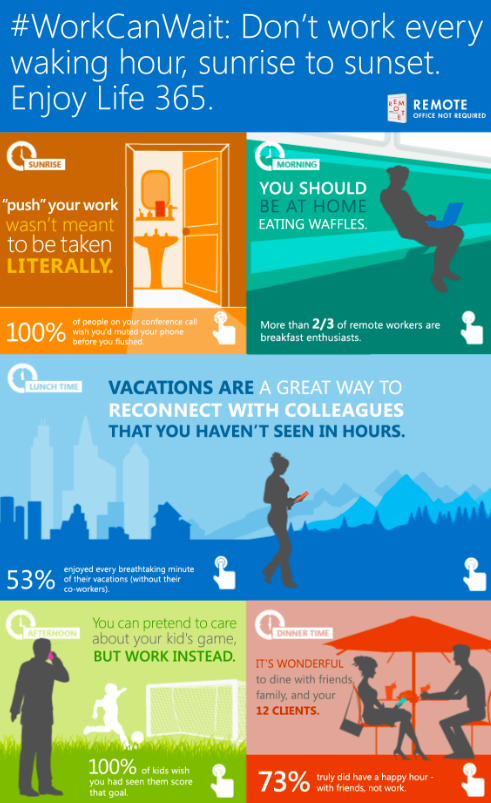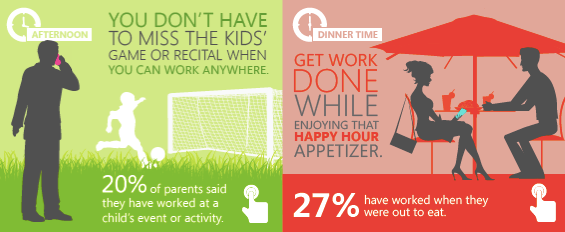We took the liberty of rewriting Microsoft’s dystopian vision of remote work ads. See more at #WorkCanWait and contribute your own revisions.
What has Basecamp helped you make?
Over 17,000,000 people around the world have used Basecamp to help them make awesome stuff. They’ve written books, renovated kitchens, built science fair projects, manufactured bicycles, planted gardens, edited magazines, designed web sites, created new brands, and walked to the south pole.
We want to see the awesome stuff that Basecamp helped YOU make, and we want to share it with the world by featuring your projects on our new site, launching in 2014.
Just fill out this form and upload a photo, video, or graphic of the thing Basecamp helped you make.
Microsoft's dystopian pitch for remote work
Microsoft is launching a new marketing campaign for Office 365 that celebrates working during your kid’s recitals, on vacation, and while enjoying the appetizer at a restaurant. All this under the guise of “balance” between work and life. Yes, it’s horrible.
Remote work is still stifled by managers who think that it’ll lead to employees goofing off, but we’re not making any progress if they switch to Microsoft’s pitch for getting to all those TPS reports from the bathroom. In fact, we’ll be worse off. Much worse.
Remote work is not about working more hours in more places. It’s not about invading every crevasse of your life and stuffing it full of work, work, work. Au contraire, mon ami. It’s about spending the hours of work more productively, and then having more time free from its tentacles.
Good ideas are co-opted and perverted all the time. Remote work is not just a good idea, but a great one. For shame on Microsoft for cheerleading its most dystopian corruption. (And no, I don’t fucking want to edit that Excel spreadsheet during happy hour.)
Everyone on Support
Earlier this year, Y Combinator partner and Wufoo founder Kevin Hale came to speak with 37signals about how to design software users love. Here’s the talk he gave at UserConf 2012, that inspired our support team to invite him to our company-wide meetup:
Kevin is big on making everyone at the company do support, and how that informs what he calls “support-driven development.” When everyone has to answer customer emails, they’re more invested in improving the product for the people who pay for and use it.
We’d considered a “5% support” model before, wherein everyone at 37signals would answer tickets one day a month. But it wasn’t primarily because we wanted everybody to get touchy-feely with customers; it was because we were drowning in tickets. We ultimately tackled that problem in other ways — by expanding business hours, hiring a few new people and creating a comprehensive help site. “Everyone on Support” no longer seemed imperative.
We were missing the main point, though. Putting designers and programmers and everyone else in direct contact with customers isn’t about putting out fires; it’s about fire safety. It’s about having the kinds of conversations that lead to better products in the first place.
The idea is hardly novel; plenty of successful companies (Amazon, Olark, Zappos) train every employee to work one-on one with customers. Paul English, CEO of Kayak, told Inc. Magazine:
The engineers and I handle customer support. When I tell people that, they look at me like I’m smoking crack. They say, “Why would you pay an engineer $150,000 to answer phones when you could pay someone in Arizona $8 an hour?” If you make the engineers answer e-mails and phone calls from the customers, the second or third time they get the same question, they’ll actually stop what they’re doing and fix the code. Then we don’t have those questions anymore.
But let’s face it: Few people are going to jump at the chance to answer tickets if they don’t have to. (“I don’t know how you guys do this every day” is a common refrain among developers who jump in on support.) Still, no one denies it’s good for them, or for the company. Ultimately, leadership has to believe it’s valuable, and be willing to get their own hands dirty too.
Fortunately, that’s the case here — after all, Jason and David used to answer all those emails themselves, so it was familiar territory. Shortly after Kevin’s talk, Jason asked everyone (via Know Your Company) “Is there anywhere we’ve been all talk and no action?”
The earful he received from the support team was what it took to finally get “Everyone on Support” implemented. Ann hopped on the case and assigned everyone in the company a “buddy” on the support team, someone they could go to with questions and who could proofread their replies if necessary.
We’ve been at it about eight months now. We still have some kinks to iron out — sometimes we’re fully staffed, for example, so the “EOS” person doesn’t have a lot to do — but for the most part, we’re pretty tickled with the results. A few discoveries we’ve made so far:
1. It’s an incredibly useful training tool. The fastest way to familiarize a new hire with our products is to have them answer questions from customers. Nathan, who joined us in July, says that he absolutely learns something new with every EOS shift. “As a new employee, that was vital to helping me understand what we’re doing and how we’re doing it. Seeing how some of our jobs get stuck in the queues (avatar uploads, project exports, daily mailers, etc.) really helped tie some of the things I see in Ops to what our customers are doing.”
2. Long-standing problems get fixed. It’s not uncommon for a designer to improve the way something is worded on our website during their EOS shift, or for a programmer to spend some time squashing a bug based on an interaction with a customer. Especially when we have sufficient coverage for the day anyway, that’s been a fantastic use of the EOS shift person’s time.
3. The workflow process has applications outside support. “My ‘real’ job is so scattered,” says Andrea, our office manager. “I’m usually working on 2-3 issues at one time. When I work EOS, I try to focus on one thing at a time, resolve. Focus -> resolve. Focus -> resolve. Applying that mentality to my real job helps me feel less scattered.”
4. It reminds us why we’re all here in the first place. Our customers are the reason we exist as a company — the reason we get to do the work we love and take home a paycheck for it. That can be easy to forget if you never interact with them. “Software engineers and designers are often divorced from the consequences of their actions,” Kevin says. Not so if everyone has a stake in making sure the product is a pleasure to use. “Ops can rapidly get detached from the customer, because all we’re doing is keeping the lights on and helping set up new apps,” Nathan adds. “EOS keeps me reminded of why we’re doing that, and how our customers use our products.”
Does everyone at your company have a chance to interact with customers? If so, tell us more about it in the comments.
Behind the scenes: Designing the REMOTE book cover
Many months ago Jason Fried asked me to think about a cover idea for REMOTE, a new book that he and David Heinemeier Hansson were writing.
I thought REWORK, their previous book, had an iconic cover. The sole image of crumpled paper alluded to “back to the drawing board.” It’s a great cover.
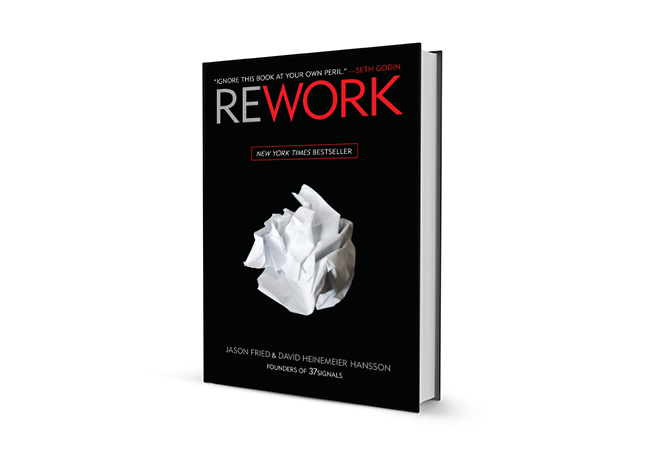
I decided early on to keep the main color scheme for the REMOTE cover: red, black, and white. I liked how the titles “REMOTE” and “REWORK” read like they’re part of a series. It made sense for them to have some relationship. I also wanted the book cover to be white. There was no meaning other than I wanted REMOTE to feel related but be visually different.
My first two covers were designed to be directly related to REWORK: title centered top with an image in the middle.
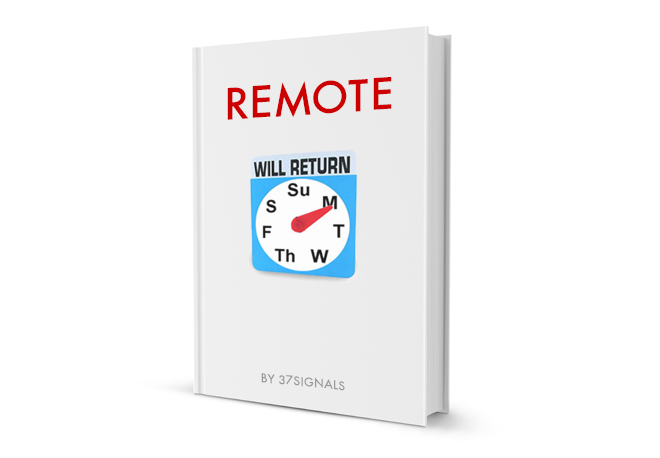
I also thought it’d be fun to try something similar in attitude to the crumpled paper.

During this time, I was reading a book by David Byrne called How Music Works. Like all (most?) designers, I’m always filing away graphics, signage, type I see every day into my brain somewhere. I appreciated the boldness of the cover design (still do).

Could I make REMOTE typography that communicates remote? I imagined an unplugged electrical cord. So, I drew and scanned one spelling out the word “Remote”.
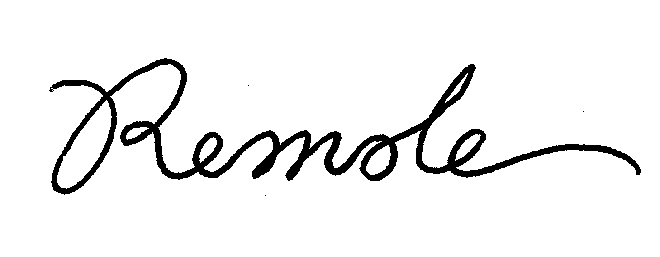
Then I traced it in Adobe Illustrator and set type around it.
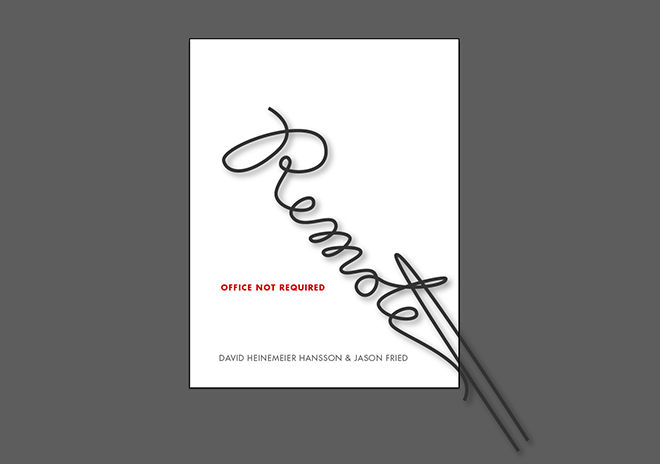
I still like this cover idea.

Then I thought about not alluding to any physical objects. Let’s not hold on to the crumpled paper. Let’s ditch cut neckties and electrical cords. Could I communicate “remote” with type in an abstract way?
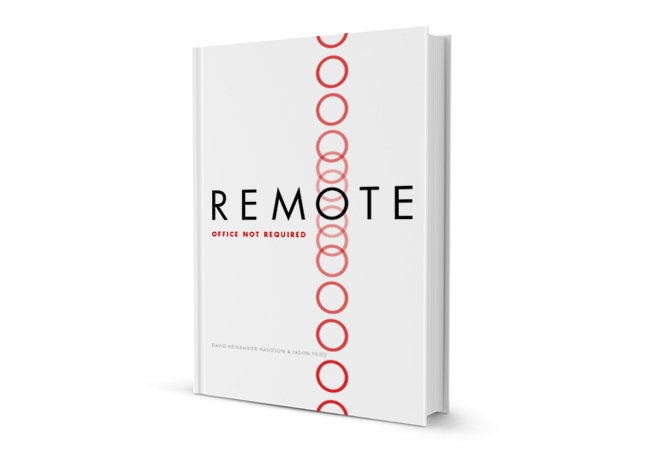
The “O” in REMOTE had a lot of potential. The perfect circle “O” (set in Futura) could act as an anchor.
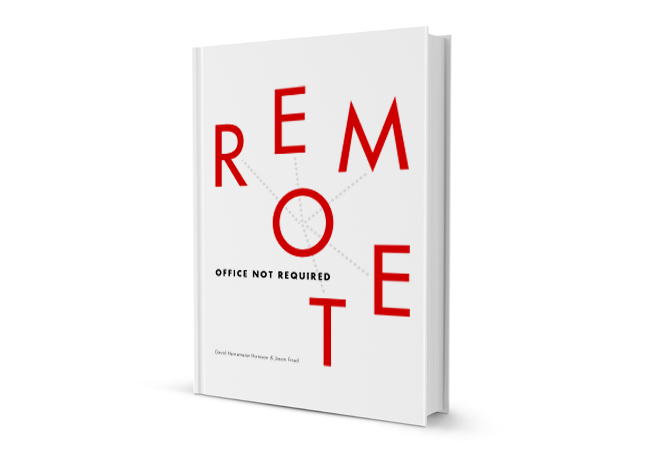
I uploaded that to Basecamp and 5 minutes later Jason Fried texts me: “You are a genius.” Actually, he didn’t say that. I can’t remember what he said because I don’t have his text anymore. He liked it.
We showed the cover to the publisher and they weren’t crazy about it. The publisher showed the cover to bookseller buyers and they didn’t like it. All the while, Jason and David kept pushing my cover design.
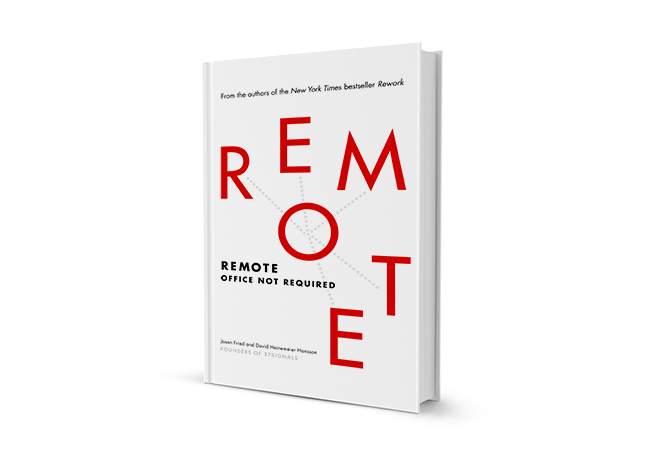
After a few tweaks and some uncertainty we had a cover for REMOTE. I’m honored that Jason and David advocated for my design. Thanks to Crown Business for going with the cover.
Pick up a copy of REMOTE if you don’t have it yet. I designed the cover.
Unapologetically cheap
The Nexus 5 is a fascinating phone. In an era where Apple has set the luxury tone, and everyone is trying to follow suit in colors and chamfered edges, Google just said no. No, it won’t be luxury. In fact, it’ll be unapologetically cheap.
That’s a refreshing breath of honesty, and a clever way to sidestep one of Apple’s core strengths. If Google doesn’t have to compete on bringing luxury to the masses, they can compete on other things.
What’s scary for Apple is just how well that strategy appears to work when the main interface of the device is just all glass. Because while the Nexus 5 comes in a cheap plastic wrapping, the screen itself is gorgeous. Big, bright, and appealing. It’s very clear that this is where the bulk of the $349 purchase price went. Well that and the fast processor.
What it comes down to is that Google has made an appliance. A boring, no-thrills appliance. This is not a work of art. But it doesn’t pretend to be a work of art. That’s what has made all the Apple imitations so pathetic for so long. Remember the HP Envy (and can you believe that HP has left that embarrassment of a video online)? If you stand in the shadow of Apple’s luxury and design prowess, you will shiver.
It takes real vision to reject the prevalent frame of the market. Google has done just that with the Nexus 5. An appliance so good for what it is, that you realize that luxury is optional.
The home screens of 37signals (2013)
Back in 2011, we shared our phone homescreens with you. We get a kick out of how others personalize their mobile phones. A lot’s changed in 2 years: retina-ized screens, bigger phones, redesigned OSes. We thought it’d be fun to see how much—if at all—our homescreens have changed. First up, the side-by-side comparisons:
Attention: there are a lot of homescreens in this post. The screens all start to blur together (apart from the Android ones), but they’re all interesting when you take the time to examine them. This is a great article for your lunchtime/afternoon break browsing…
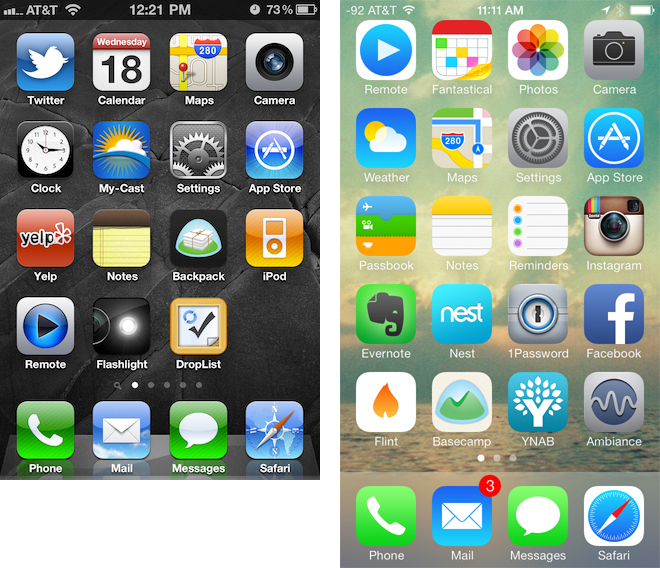
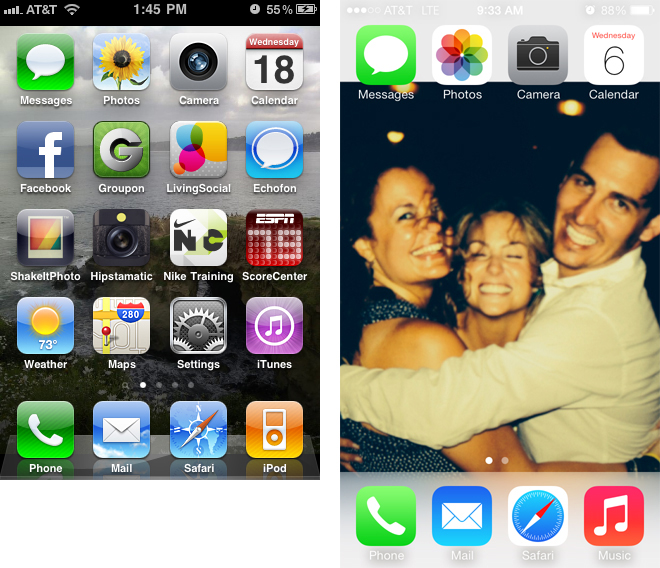
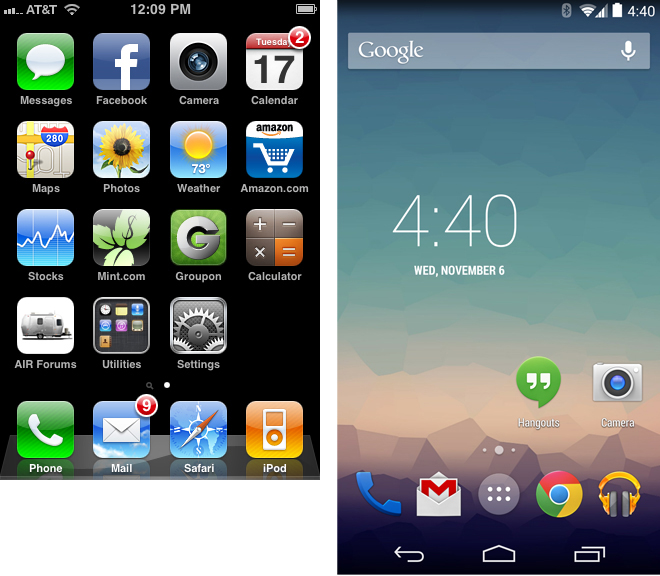
Our new job board: WeWorkRemotely.com
We’ve been running our job board since 2006 and connected thousands of talented people with great jobs. It’s been a great place for people who got the ethos of REWORK to find like-minded individuals. More than 100 positions are currently listed.
It’s been a great run, but it’s time for something new. As a company, we’re obviously big supporters of working remotely. We’ve been doing so for the last decade. 75% of our people are working remotely. We just wrote a new book, REMOTE: Office Not Required, about the why and how. Now we want to help highlight forward-looking companies who’ve decided that they too could benefit from the best talent regardless of where they live.
WeWorkRemotely.com is our brand new job board, reserved exclusively for remote job listings. We’re making it completely free to post for the first 24 hours! After that, the 30-day rate is going to be half of what it was on our old job board, just $200.
The traditional you-must-commute-to-our-office job situation has plenty of outlets. Here’s an outlet for those who go beyond that. Enjoy!
Read sample chapters from REMOTE in Inc. Magazine
In addition to Jason’s regular “Get Real” column in Inc., the magazine reprinted several chapters from REMOTE: Office Not Required. If you haven’t already read it or ordered your copy, they’re a great sneak preview!
Hey, Marissa Mayer, You’ve Got it Wrong: Telecommuting Isn’t A Bad Thing. It’s The Future
If you ask people where they go when they really need to get work done, very few will respond “the office.” If they do say the office, they’ll include a qualifier such as “super-early in the morning before anyone gets in,” or “I stay late at night after everyone’s left,” or “I sneak in on the weekend.”
Why Face-To-Face Meetings Are Overrated
How many breakthrough ideas can a company actually digest? Far fewer than you imagine. Most work is not coming up with The Next Big Thing. Rather, it’s improving the thing you already thought of six months — or six years — ago. It’s the work of work.
Working From Home Boosts The Quality Of The Work
When you can’t see someone all day long, the only thing you have to evaluate is the work. A lot of the petty evaluation stats just melt away. Criteria like “Was she here at 9?” or “Did she take too many breaks today?” or “Man, every time I walk by his desk he’s got Facebook up” aren’t even possible to tally.
How To Work With Clients You’ve Never Met Face To Face
It may be irrational but, if you’re local, the client often feels that, if worse comes to worst, they can knock on your door. They “know where you live.” But when you’re remote, they’re going to be more suspicious when phone calls go unreturned or emails keep getting “lost.”
The True Challenge of Managing Remote Workers: People Who Work Too Hard
A manager’s natural instinct is to worry that her workers aren’t getting enough work done. But the real threat is that they will wind up working too hard. And because the manager isn’t sitting across from her worker anymore, she can’t look in the person’s eyes and see burnout.
The Two Biggest Drags On Productivity: Meetings And Managers (Or, As We Call Them, M&Ms
These two staples of work life — meetings and managers — are actually the greatest causes of work not getting done at the office. In fact, the further away you are from both meetings and managers, the more work gets done. This is one of the key reasons we’re so enthusiastic about remote work.

